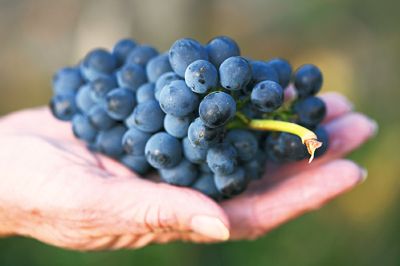Second to One

By Karl Klooster
There can be no argument that Pinot Noir, the noble Burgundian red, has secured its place as Oregon’s signature wine. Throughout the Willamette Valley, it dominates in both prestige and total production.
Even in Southern Oregon, where several noted warmer climate varietals are making their mark, the acreage devoted to Pinot Noir is more than double its nearest rival.
But what of the state’s other important wine varieties?
Pinot Noir accounts for 12,265 acres, or 60.4 percent, of the 20,300 acres planted to wine grapes in Oregon vineyards. That means other varieties occupy 8,035 acres.
Four white varieties, led by Pinot Gris, play significant roles on the statewide scene. The Alsatian variety’s total of 2,707 acres puts it far ahead of Chardonnay, a distant third at 942 acres.
Pinot Gris has been a boon to growers and producers in both the north and the south, owing to the fact that it is relatively problem-free in the vineyard and produces high-yield, well-balanced wines under a variety of conditions.
Add to that, its fresh, bright, fruity profile, which practically begs for early, easy drinking, and the term “cash cow” comes to mind.
It’s not that Gris can’t be a serious wine. It’s a matter of handling and, of course, the origin of the underlying clones.
In that word, “origin,” lies the single most vexing misconception under which Pinot Gris labors.
The vast majority of Oregon wineries seek to emulate the zesty, flavorful, fruit-driven mouthful of wine produced by vignerons in Alsace, the northeastern corner of France that is as much Germanic as it is French.
However, its reputation has been somewhat sullied by the Italian pretender, Pinot Grigio, a light, often single-dimension quaff whose typically modest price reflects its predictably mundane quality level.
A handful of Oregon wineries have further blurred the difference by labeling their wines Pinot Grigio and striving for the fuller style, thus creating even more confusion among consumers.
One can only wonder whether Grigio benefits more from the positive impression of Gris or Gris suffers more from the image ordinaire of Grigio. Perhaps it’s a draw, which, unfortunately, would likely still mean a loss for Gris.
As for Chardonnay, the consensus is that, at its best, it wins the dry white table wine sweepstakes hands down.
The great Montrachet, Meursault and Chablis of France stand as testament to that statement. And other places around the globe, certain parts of California perhaps most prominent among them, make the queen of white sing an olfactory aria reaching lofty heights.
Whether or not an Oregon winery can bring this diva to the stage, however, remains to be seen. Thus far, a few very nice, stylish Chardonnays have come forth, but they have been the exception.
By and large, Oregon Chardonnays have been more in the class of good efforts from Australia and Chile, rather than something approaching a Meursault, much less a Chevalier-Montrachet.
Still, the Oregon Chardonnay Alliance, a dedicated group of eight Willamette Valley winemakers, soldiers on. Members hold the firm conviction that Dijon clones grown the proper way in the right place, then creatively crafted, will ultimately lead to success.
Fourth, production-wise is white Riesling, whose favor and popularity appears to be on the rise. Currently, 797 Oregon acres are planted to Riesling, with more seriously being contemplated, if not already in the works.
Don’t be confused by the intermingling of the terms “White Riesling” and simply “Riesling.” Whereas at one time, the latter might have been used misleadingly to disguise an inferior variety, the odds of seeing that today, at least domestically, are essentially nil.
What you might more likely find under the Riesling name in Oregon is one of the best quality wine values available on retail shelves around the Willamette Valley.
In the frenzy to identify Oregon with Pinot Noir, the industry neglected this famed Germanic variety, even though Europeans have long classified it among the world’s noble wines.
At last, Riesling is beginning to emerge from the shadows in Oregon. It is becoming recognized as a cool-climate variety that has proved it can do well in selected areas of the state and is ready to stretch its legs a bit.
More Willamette Valley winegrowers are contemplating whether or not the vine might do well on cool, hilltop blocks with less-than-ideal facings. In Southern Oregon, certain cooler spots — and drier than in the north — appear favorable.
In the Gorge, the hot days and cool nights have emboldened a few growers to plant Riesling with positive results. The possibility it could do well east of the Cascades is even coming under consideration.
Rieslings fermented to full dryness exhibit the floral and citrus aromas and the crisp, apple, peach and freshness. Such wines can live many years if well stored, then reward with multi-layered nuances.
This is not to mention their proven potential as dessert wines. But sweet, even sweet with gobs of lush, multi-layered character, is a subject that seldom comes up among mainstream American wine drinkers.
Betting on the resurgence of Riesling are members of the Oregon Riesling Alliance, currently 38 strong. The roster includes both boutique and higher-volume wineries, all of which are convinced the grape can carve out a permanent place in the state’s wine future.
Viognier, Pinot Blanc, Gewürztraminer and Sauvignon Blanc all boast their champions among Oregon winegrowers. Some have already forged distinct identities and become role players in various parts of the state.
But among them, only Viognier, the rich, round white wine from France’s Rhone Valley region, would appear to possess the potential for significantly increased production, thus positioning it for prominence in the wider marketplace.
Among reds other than Pinot Noir, Cabernet Sauvignon, Merlot and Syrah lead the pack. Together, the three varietals account for 1,686 acres closely divided between Southern Oregon and Columbia River appellations.
In the Columbia Gorge and Eastern Oregon, 859 acres out of the region’s 1,707 total vineyard are devoted to the three popular reds. In Southern Oregon, their aggregate is 737 out of the AVA’s 3,012 planted acres.
Clearly, the Columbia River scales are tipped significantly toward the two Bordeaux and one Rhone red. Jackson and Josephine counties place a strong dependency on the three as well, with 611 of their 2,003-acre combined total planted to them.
Unlike their more southerly neighbors, Douglas County’s Umpqua Valley growers have taken a somewhat divergent course. Pinot Noir dominates the combined acreage of Cabernet, Merlot and Syrah nearly four to one. But another variety is gaining prominence.
Plantings of the famed Spanish variety, Tempranillo, remain relatively small at 173 acres statewide. The vast majority is in Douglas County, where wineries led by Abacela have become serious contenders on the world wine scene.
Two other varieties deserve mention as well, though the attention paid to their cultivation and development may rest in the hands of a handful of champions who have taken a particular liking to them.
They are Pinot Blanc, whose 105 Yamhill Valley acres represent more than half the state’s 207 total, and Gewürztraminer, whose 215 statewide acres are widely spread from north to south.
Pinot Blanc, a mutation of Pinot Noir, suffers from lack of identity. It has a blank palate like Chardonnay, but unlike Chardonnay, it seldom receives the time, attention and costly oak barrels that would allow the best of its malleable nature to show through.
As a consequence, Pinot Blanc has been relegated to little more than a pleasant quaff, making its long-term future uncertain. Like others with no distinct niche, it may remain relatively obscure.
Gewürztraminer, on the other hand, countenances no lack of commitment. People either love it or don’t. The wine’s assertive spiciness, intermingled with lush stone-fruit flavors, is at their most delightfully distinctive in a dry style.
The problem is, it’s tough to ferment fully dry and still maintain balance. It’s much easier to mask small flaws with a little sugar. Still, quality Gewürz has its committed fans. And a handful of local producers are measuring up to the task of producing it.
Wherever you go in Oregon wine country, there will be something exciting to sip and savor. With all the varying options around the state, having the opportunity to try as many as you can over time is bound to expand your perspective.










